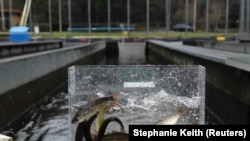For several years, Fawn Sharp has seen her tribe on the west coast of the United States move from one crisis to another.
Sharp lives in Washington state and belongs to the Quinault Indian Nation. Rising sea levels have caused flooding in the tribe’s main village. In nearby rivers, sockeye salmon have all but disappeared. The shrinking numbers of fish have affected the tribe’s finances and culture.
Sharp is president of the Quinault. She has plans to move the tribe to higher ground, bring back the salmon and change the local economy. But these plans are slow at taking shape, and Sharp blames a lack of federal money to help Native Americans deal with climate change.
The Quinault’s struggles reflect the problems faced by Native Americans, who are among those most at risk to the effects of climate change. That is a finding from a report called the National Climate Assessment. It was a project of U.S. federal agencies.
The report says Native Americans often depend on nature for food, jobs and trade. Southwestern tribes, such as the Navajo Nation, face water shortages as the Colorado River dries up. Some northern tribes are experiencing crop shortages because Lake Superior is warming.
Money needed
Tribes are finding it difficult to get the equipment they need to deal with increasing threats from storms, flooding, wildfires and other natural disasters. They do not have the money to buy the equipment, and the federal government offers little help.
The Interior Department’s Bureau of Indian Affairs provides $10 million a year for tribal climate resilience planning nationwide. The Federal Emergency Management Agency provides another $20 million to tribes under a program to protect communities from natural disasters.
That is not enough money when spread among more than 500 tribes, notes Fawn Sharp. She has made climate change the top issue in her new job as president of the National Congress of American Indians, which represents 535 registered tribes.
In addition to pressing federal officials for more support, Sharp is targeting the businesses that cause pollution and climate damage. To finance the move of some tribe members, she plans to ask for a carbon tax for companies doing business on the reservation. The measure would make her tribe the first in the United States to price carbon.
Sharp is also considering legal action against big oil companies she believes should help pay the cost for climate-damage.
“Those who are…responsible for causing the damage should be paying,” she said, for “generations of exploitation.”
An oil industry group would not comment on possible legal action. It said only that oil companies and tribes should be “working with each other and not against each other.”
Disappearing salmon
Shane Underwood directs the Quinault Indian Nation’s fish processing center in Taholah, Washington. On a recent morning, she grew frustrated by another small catch of fish. A single fisherman had arrived with five salmon after spending hours on the river.
The salmon is important to Quinault culture. It is often used in artwork and on tribal buildings. It is the traditional meal for families. Now, it is at the center of the issue of climate change.
A glacier in the Olympic mountains once cooled the Quinault river system, but it melted nine years ago. The river has warmed, leading to problems for the salmon, explained Justin James. He is a cultural historian who specializes in forest, fish and wildlife for the Quinault Environmental Protection Department.
The Quinault’s Business Committee is trying to increase the salmon population. It also is launching a $1.2 million project to improve the floodplain on the Upper Quinault River in hopes of creating a better salmon environment.
“We have been eating the salmon for thousands of years,” James said. “It’s our spirit, our heart.”
Higher ground
The Quinault Nation is trying to defeat another threat – flooding of its village.
In 2017, the Quinault agreed on a plan to move nearly 700 people and some important buildings to higher ground. The whole relocation project will cost up to $150 million.
Some work has already begun in the new village, using $15 million worth of tribal money. But finishing the entire relocation project is costly, and the tribe does not have the money. A bill asking Washington state to pay for part of the move was defeated in the legislature.
“That was probably the lowest point I had hit in all my years of this climate struggle,” said Sharp.
I’m Jill Robbins.
The Reuters News Agency reported this story. Susan Shand adapted it for Learning English. George Grow was the editor.
________________________________________________________________
Words in This Story
reflect – v. to demonstrate or show
reservation – n. land given to Native Americans for their homeland
resilience – n. strength and fortitude
carbon – n. a chemical element that is found in oil products and leads to pollution
exploitation – n. the use of something or someone in a way that helps you unfairly
frustrate – v. to annoy
glacier – n. a large piece of ice








